What is Rehabilitation Therapy for Pets?
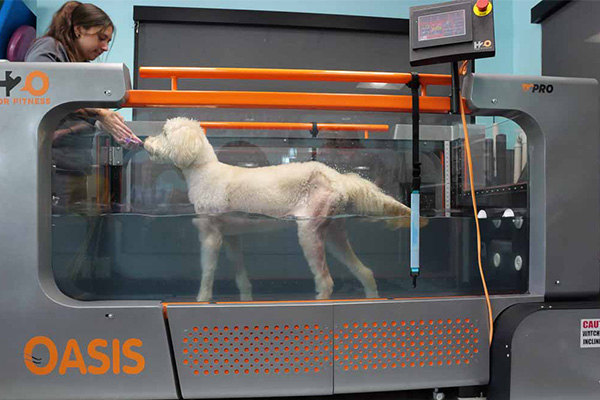 Rehabilitation therapy is a specialty in veterinary medicine involving one-on-one, hands-on work with your pet to help them regain their agility, ease their pain, increase their flexibility, strengthen their muscles, and improve their health. Rehab therapy uses tools like e-stim, ultrasound, laser, and various equipment, like an underwater treadmill.
Rehabilitation therapy is a specialty in veterinary medicine involving one-on-one, hands-on work with your pet to help them regain their agility, ease their pain, increase their flexibility, strengthen their muscles, and improve their health. Rehab therapy uses tools like e-stim, ultrasound, laser, and various equipment, like an underwater treadmill.
This aspect of veterinary medicine includes diagnosing and managing pets with painful or movement-limiting symptoms involving the pet’s neurologic and musculoskeletal systems. The therapies focus on regaining the highest level of function and quality of life possible. Harmony Animal Hospital has a certified animal rehabilitation veterinarian and rehab nurses who assist. If your primary care vet is elsewhere, we will work closely with them to coordinate your care. At Harmony, we can prescribe pain medications as needed and offer a wide range of therapies with a multi-modal approach that leads to the best outcomes.
Reduce pain. Ease healing. Increase range of motion and independence.
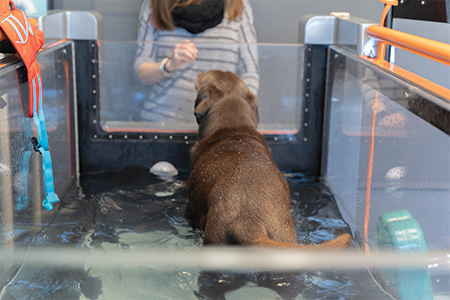 Why Do Pets Need Rehabilitation Therapy?
Why Do Pets Need Rehabilitation Therapy?
Harmony Animal Hospital’s canine and feline rehabilitation center helps your pets recover with less pain, sooner, and with greater ease. Rehab therapies are done for three main reasons:
- To help recovery from surgery, illness, or injury;
- To enhance the performance of working dogs; ,
- To ease discomfort and help with mobility in senior dogs;
- To improve body awareness and neurologic function at all life stages.
Support Recovery from Surgery, Injury, or Illness
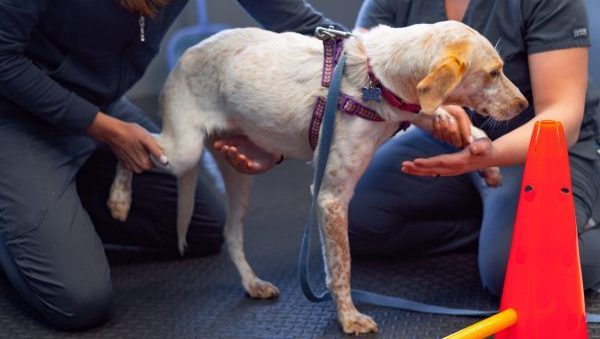
Post Operative Orthopedic Injuries
- Patella
- Hip
- Cruciate Ligament
- Limb Fractures
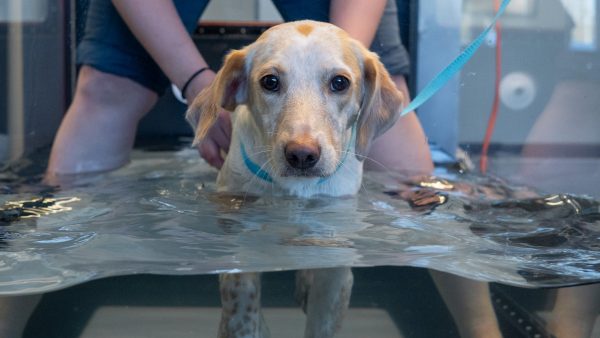
Chronic Orthopedic Conditions
- Arthritis
- Hip Dysplasia
- Tendinopathies (soft tissue injury)
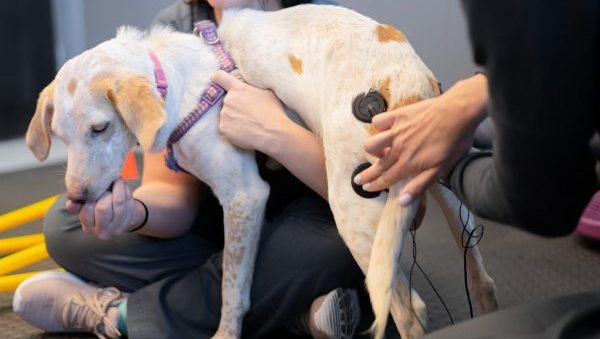
Degenerative Neurological Conditions
- IVDD (Intervertebral Disk Disease)
- Lumbosacral Disease
- IncontinenceVestibular Disease
- Degenerative Myelopathy (DM)
- Geriatric Onset Laryngeal Paralysis and Polyneuropathy (GOLPP)
- Wobbler Syndrome
Enhance Performance of Working Dogs
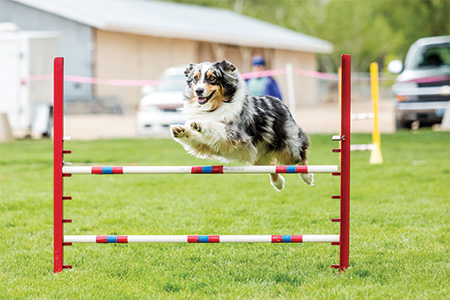
For Performance Dogs
- Canine Agility
- Flexibility
- Endurance
- Pain Relief
- Weight Loss and Conditioning
Relieve Pain & Help Mobility in Senior Pets
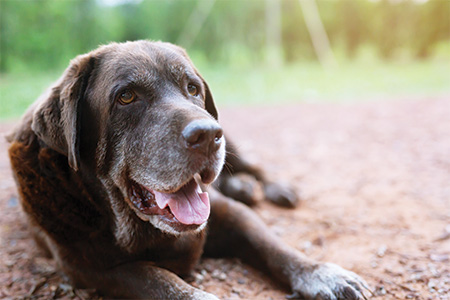
For Senior Pets
- Arthritis
- Difficulty Walking
- Hip pain
- Hind End Weakness
- Muscle Loss
- Incontinence
- Weight Loss
Improve Body Awareness and Neurologic Function

For Young Pets
- Better paw coordination
- Improved form for long term exercise health

For Senior Pets
- Hind end weakness
- Geriatric Onset Laryngeal Paralysis and Polyneuropathy (GOLPP)
- Hind end muscle atrophy
- Dragging paws
Pain Management
As in human medicine, good pain management for our pets is also necessary to speed healing. Pain is not only stressful and uncomfortable, but it can also impede the healing process. So, managing your pet’s pain goes hand-in-hand (or paw-in-paw) with our rehabilitation exercises. It is often the first step towards healing.
Traditionally, veterinary medicine has looked to prescription medications and strict cage rest to manage pain in animals. With advances in physical rehabilitation techniques in veterinary medicine, additional tools and approaches such as manual therapies (including massage, cupping, K-tape, etc), acupuncture, electrostimulation, PEMF therapy, laser therapy, and structured, controlled exercise plans have become an accepted—and proven—means of helping pets more fully and quickly recover from injury, surgery or chronic degenerative conditions. Our approach is to treat our patients using a wide range of treatment options. We focus on the whole pet, treating compensatory pain in addition to the primary injury/illness to help our patients recover as fully as possible.
Note: Please do not give human pain medicines to your pets. Pets are not little humans. Always consult with your veterinarian before administering any medications.
Integrated Veterinary Medicine & Rehabilitation Therapies for Pets
You’ll be relieved to know that Harmony Animal Hospital has in-house rehabilitation for your dogs and cats, should they need it. Pet owners come to us from around the Raleigh-Durham metro area and the greater NC Triangle region, as well as from Charlotte, Fayetteville, and Virginia, especially if we have treated their pets before.
Harmony offers multi-modal and conventional therapies, including acupuncture, hydrotherapy with an underwater treadmill, laser, electrostimulation, therapeutic ultrasound, cupping, kinesiology taping, and a therapeutic exercise program for our patients. Our rehabilitation therapist is certified in western based acupuncture.
Meet Dr. Mikaela Archambeault and Our Rehab Nurses
Dr. Mikaela Archambeault directs our canine rehabilitation program. She is certified in acupuncture through CRI (Canine Rehabilitation Institute) and has training in additional soft tissue mobilization techniques, including cupping, scraping, and kinesiology taping.
Dr. Mikaela and our vet rehab nurses will work in a variety of ways with your dog or cat. They will consider the problem, the expectations for recovery, and your pet’s age and health in designing the right rehab plan to get them where they need to be.
Hydrotherapy Using Underwater Treadmill
The water in our underwater treadmill supports your dog’s weight and allows them to learn to walk again without pain in weight-bearing joints. Sometimes we may fit your dog with flotation devices (life jackets) and allow them to swim in the underwater treadmill. Needless to say, some dogs take to water exercise more readily than others. Some cats even enjoy water therapy. Dr. Mikaela will work with you to decide if this treatment option is right for your pet.
Benefits of Using a Treadmill
- Improves range of motion
- Strengthens muscles and boosts endurance while decreasing weight on joints
- Aids with neurological impairments and weight loss
- Rehabilitates soft tissue injuries and provides osteoarthritis relief
- Provides relief to a pet that recently had a limb amputated
How does the underwater treadmill work?
Our rehabilitative therapist will introduce your pet to the treadmill and the water level at their own pace. This will allow your pet to get accustomed to the equipment and their surroundings. We use warm water for your pets to help them relax and feel comfortable. Small dog breeds and cats require extra special care, so our therapist or rehab nurse will be in the tank with them throughout the entire session to make sure they feel calm. We also set the temperature slightly higher (88-92 Fahrenheit) to help them relax.
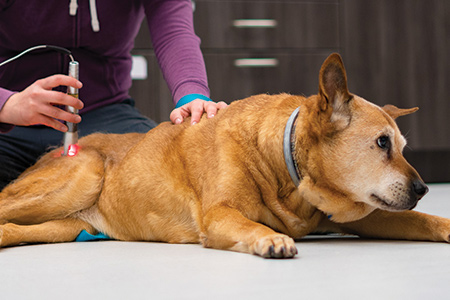
Energy Therapies – Laser, Ultrasound
Animals with open wounds or stitches can’t go in the water, so there are other forms of energy therapies – such as laser, ultrasound, neuromuscular stimulation, transcutaneous electrical nerve stimulation (TENS), or E-Stim – that can be utilized. These therapies bring warmth and circulation to the injured area and promote healing.
PEMF (Assisi loop, Respond bed)
PEMF stands for pulsed electromagnetic field technology. It is a non-drug treatment, used for pain, inflammation, wound healing, osteoarthritis, and post-surgical healing. It is used by placing the loop on or around the area needing healing or pain relief or by having your pet lay on the bed. Treatments can even be used 2-3 times a day.
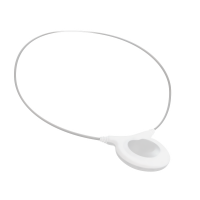
Assisi-loop
Acupuncture
Acupuncture is the placement of needles into specific points along energy pathways called meridians to achieve a desired effect of movement of energy (or Qi – pronounced Chi). When a needle touches certain points in the body, it stimulates the release of endorphins, also known as the feel-good hormones that ease pain and relieve tension. This is why acupuncture not only helps with physical pain but also causes an overall feeling of calm and relaxation in its recipient. The goal of acupuncture is to help your pet’s body heal itself. While some spots can be initially irritating on placement, most acupuncture points are comfortable when placed, and pets generally seem unfazed.
Not only does acupuncture release anti-inflammatory and pain-relieving hormones, but it can also:
- Improve skin problems (ex. allergic dermatitis, hot spots, or granulomas)
- Aid in normalizing gastrointestinal issues
- Provide relief to asthma and allergies
- Enhance blood circulation and stimulation to the nervous system
Acupuncture has also been effective in treating a host of traditional pet diagnoses. Ask Dr. Mikaela when you meet with her.
Herbal Therapy
Herbal therapies are frequently used on pets in Eastern countries, and they’ve been used to treat humans since 3000 B.C. in China. It’s a growing field in Western veterinary care. Harmony does not offer herbal therapy at this time.
Hands-on Therapies
We offer hands-on therapies like massage and guided stretching that can help to relax painful muscles and restore the range of motion to joints. Manual therapies are also helping in restoring mobility of the fascia under the skin, an area we are finding to be imperative in restoring comfort and mobility in patients. Massage increases circulation to improve healing, decrease pain, and reduce swelling. Massage can also be used for acute or chronic problems as it increases blood flow, which improves oxygen delivery to tissues, and breaks down scar tissue. Massage also promotes mental and physical relaxation. We also offer cupping and scraping as two additional techniques to help with improving movement of the fascia and skin as well as blood flow to affected areas.
Therapeutic Exercise
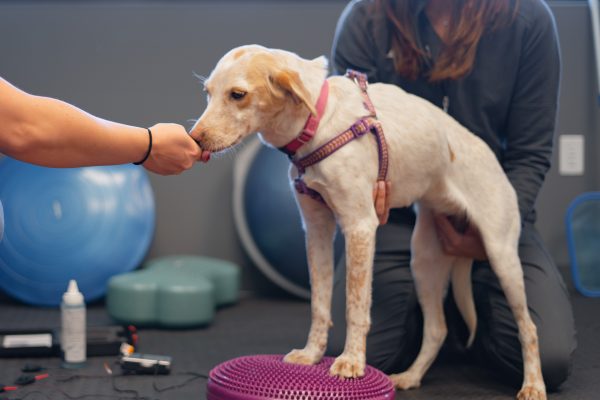 Therapeutic exercise consists of active range of motion (AROM) and stretching exercises as well as strength exercises. These exercises help maintain or improve range of motion of joints; aid in the body’s awareness of neuromuscular structure and function; and improve the flexibility of muscles, tendons, and ligaments.
Therapeutic exercise consists of active range of motion (AROM) and stretching exercises as well as strength exercises. These exercises help maintain or improve range of motion of joints; aid in the body’s awareness of neuromuscular structure and function; and improve the flexibility of muscles, tendons, and ligaments.
Active exercise involves your pet moving themselves (with guidance from a human). We work with your pet in our gym and instruct you on how to perform these exercises with your pet at home, often through video. These exercises work on site-specific strengthening, balance, and improving core strength. Some examples include:
- Cavalettis
- Physioball exercises
- Balance board/BOSU exercises
- Therabands
- Weight shifting
- Sit-to-stand exercise
- Standing exercises
- Wheelbarrowing
- Stair climbing
At-Home Exercises
When we develop a rehabilitation plan for your pet, it will most likely include some exercises to do at home in-between visits. At home exercises are paramount in your pet’s healing and are the key to seeing the biggest improvements. Our rehab team will work with you to make sure we have the right exercises for your pet as well as ensuring that you feel comfortable carrying them out effectively at home to ensure lasting success. Examples include working with your dog on a balance board, doing wheelbarrows, or using Therabands.
Assistive Technology
If your pet’s injury is permanent or lasting, you may want to investigate assistive technology to make life easier and more enjoyable for your pet, as well as for you. Dogs can’t use crutches, but they can be fitted with a two-wheeled cart that lets them get around any flat area on their own power. We then work with your pet to teach him how to navigate in the cart. If steps are the problem and you are able-bodied, we can get a fitted lifting harness with a handle on the top so you can offer a boost when you come home from a walk and need to get up the steps to the front door. When your dog’s injury involves amputation, remember that dogs do pretty well on three legs, particularly if it is a hind leg that is amputated, but prosthetic legs can be fitted for some animals, too.
How Will You Know Your Pet Needs Rehab Therapy?
If it’s post-op, our veterinarians will discuss what we can do to aid in your pet’s recovery.
Pet injuries and illnesses are often similar to those of humans. Pets are susceptible to arthritis, torn ligaments, injuries to nerves, broken bones, gastrointestinal problems, thyroid issues, and more. It is not always obvious that your pet is experiencing pain from injury or discomfort, so here are some signs to be on the lookout for:
- Decrease in energy or enthusiasm
- Difficulty with turns or obstacles
- Inability to sit down squarely (sitting awkwardly or in a slanted position)
- Difficulty getting up or going up and down stairs
- Holding a leg up while standing
- Walking with a limp
- Signs of paralysis
- Diarrhea
- Respiratory problems
- Urinary incontinence
If you notice your pet displaying any of these signs or any other worrisome symptoms, schedule an appointment with one of our vets to discuss possible causes and which medical and/or rehabilitative treatments might best ease your pet’s symptoms and aid in recovery. As our pets get older, they can lose muscle mass from arthritis or other chronic conditions and develop weakness in the back end. Rehabilitation therapy can be more successful if pursued earlier in the stage of disease rather than waiting until our pets cannot walk anymore.
Call Harmony for an Evaluation
When your best friend needs help getting out of bed, give us a call. We can’t promise she’ll be back running marathons, but there is a lot we can do to help her live the fullest life possible.
How long does a session last?
Individual pets have different needs, so our therapist will create a program tailored specifically to your pet.
Initial Rehab Evaluation is 90 minutes.
Follow-Up Sessions are 30 – 60 minutes.
Pet Owners Are Welcome. You are welcome and encouraged to be present when we evaluate and work with your pet. We often ask that you do exercises at home with your pet, and keep a log of what you do so that we can measure progress.





